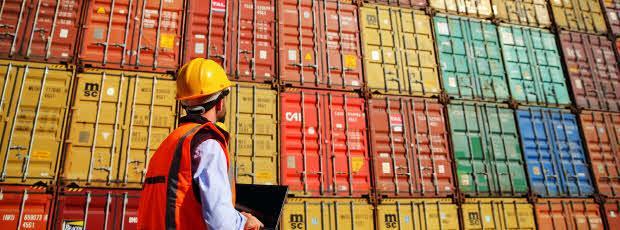The seven key developments in trade finance in 2020
2020 has been a game-changing year for trade finance. From the impact of COVID-19 and ongoing geopolitical upheaval, to accelerated digitisation of trade finance processes and its role in fraud detection, our in-house experts weigh in on seven of the latest trends and key developments in trade finance that business leaders should keep in mind when planning ahead for 2021.

1. Silver linings: accelerated digital adoption
In every cloud, there is a silver lining. John Laurens, Group Head of Global Transaction Services, DBS, commented, “As the world continues to navigate the worsening US-China relationship and the technology-driven trade war, together with the far-reaching consequences of COVID-19, we must look for and take advantage of any silver linings.” And one of these is the acceleration of digital adoption.
Since the start of the crisis, DBS has worked at a frenetic pace with customers to co-develop and implement a range of digital solutions to fast track digital transformation. The rate of adoption has sped up by as much as 3-4 years within the first six months of 2020 alone. As a result, transactions initiated through digital solutions have grown exponentially across every market.
2. ASEAN benefits from the growing trade war
2020 has presented several other challenges outside of the pandemic, one being the escalating trade tensions between US and China. Given that most nations have China as their largest trading partner, and that China factors heavily in many companies’ supply chains, US-China trade tensions have caused China to pivot their focus on trade with ASEAN countries instead, resulting in a 1% year-on-year increase in China-ASEAN trade.
Among the ASEAN countries, China’s bilateral trade with Vietnam has seen the most dramatic increase, with outbound shipments to Vietnam soaring five-fold in value over the last decade and China’s imports from Vietnam recording an astonishing surge of more than 25% year-on-year as of June 2020.
3. Supply chain management has undergone a digital-physical reset
COVID-19 has uniquely exposed a critical vulnerability in bank-intermediated trade finance, specifically, the reliance upon paper-based processes. The pandemic has proven to be a catalyst for rapid digitalisation of trade and supply chain finance, signalling an end to archaic paper-based methods.
DBS’ digital savviness and leadership in areas such as digital customer onboarding, digital documentation, and API connectivity, particularly with cloud-based applications, have helped enable more rapid digital adoption in supply chain management. SMEs have turned out to be more agile and better poised for digitalisation than larger MNCs grappling with legacy systems and applications, allowing them to take full advantage of the digital-physical reset.
4. Digitisation can aid in fraud detection – but is not a silver bullet
As Amit Agarwal, Executive Director & Head of Open Account Trade Products, Global Transaction Services, DBS, puts it, “Greater trade digitisation will help reduce fraud. The human-centric behavioural nature of fraud can be detected and digitised through AI, which can recognise patterns of fraudulent behaviour or spot potential risks early. Additionally, IoT mechanisms and tools can digitalise physical checks for fraud detection, increasing efficiency and accuracy.
However it must be recognised that while trade finance has experienced significant advances due to digitisation, it is not a silver bullet against fraud. Effective fraud detection still demands vigilance and the continuous improvement of tools we have to detect fraud.”
5. Better fraud detection relies on connected government action
Several industry experts, including Amit Agarwal, have said that fraud is much easier to detect from a single platform. The reason for this is authenticated data sharing. However, we are still a long way from all being on that single platform.
Notable progress has been made by individual governments in the region who are taking steps toward digitising trade platforms – Singapore has its Network Trade Program, Hong Kong its e-Trade Connect, and China its digital trade finance platform – but more needs to be done overall to consolidate trade data for more effective fraud detection. Government-to-government communication via digital platforms is critical to driving industry behaviour toward building up a network of networks.

6. Commodity prices remain volatile due to exposed supply chains
Sriram Muthukrishnan, Group Head of Trade Product Management, Global Transaction Services, DBS, pointed out how the pandemic has placed immense pressure on the commodity trading sector. “From the impact of negative oil pricing to concerns over what to do with millions of tons of soft commodities, the pandemic, combined with geopolitical problems, has placed strain on commodity trading.”
However, there are pockets of resilience. For example, iron ore demand from China has bounced back, suggesting that market demand isn’t eroded forever, but instead is short term. However, the issue is that no one knows precisely how long the “short term” will last.
7. Don’t neglect SMEs
While the pandemic has affected everyone, some are more vulnerable than others. SMEs have received the brunt of the impact, as smaller businesses typically don’t have credit facilities to draw down on to tide them through rough times, like larger corporates do. While there have been several government relief measures to support SMEs, many continue to struggle.
John Laurens noted the importance of banks to provide liquidity assistance to SMEs, “It is critical in these times for key anchors in the supply chain to provide SMEs with working capital through supply chain financing programmes.” With SMEs forming the lifeblood of most ASEAN economies, employing almost 97% of the region’s population , it is in the interest of all to help SMEs survive and thrive in the new normal.
Digitisation and ‘coming together’ is key to a successful future
As Sriram Muthukrishnan put it, the situation brought about by the pandemic has provided the impetus for so many positive changes, with digitisation being fundamental to many of these. With the requirement for financing – engaging customers and ensuring transparency – digital can play a significant role.
Another much-needed change brought about by COVID-19 is the need to engage regulators and the trading community to come up with common standards of behaviour. “Almost all the banks are here to stay – liquidity is not a problem. The trade finance community needs to come together to support businesses.”
There is no question – 2020 has presented significant challenges for global trade finance. But it has also presented a unique opportunity to overhaul outdated processes for better efficiency, transparency and cost-efficiency. As we get ready for 2021, we look towards a future in which we are better prepared through increased digitisation, diversified supply chains and greater impetus for a unified trade finance community.


